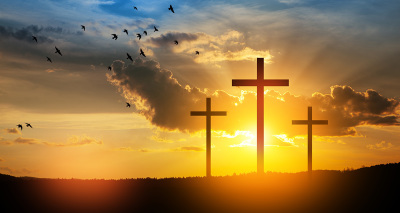
“I missed a spot.” We all know the disappointment of finishing a project only to find a mistake or something we missed. With home renovations, crafts and carefully nurtured gardens, there are almost always things we wish we did differently. Resurrection Day reminds us that, even if we look back on our works with regret, God does not.
On the cross of Calvary, there was no such regret. After His ultimate sacrifice, Jesus did not say, “I could have done more.” He didn’t second-guess his work. Instead, the words of our Savior rang out loud and clear: “Tetelestai” or “It Is Finished.”
“Tetelestai” comes from the Greek word “teleos,” a word that implies that something is finished. When Jesus declared, “tetelestai,” He announced the fulfillment of the divine plan, a plan that had been in motion since the very creation of the universe.
To understand the magnitude of what was “finished,” we must return — not just to the cross — but all the way back to Genesis, to the very beginning, when the world was new, untouched by sin and utterly perfect.
The Bible tells us that at the end of the creation week, God looked at everything He had made and declared it “very good.” As someone who loves to explore the wonders of nature, I’m constantly amazed by the intricate beauty of God’s design. From the delicate symmetry of a snowflake to the harmonious rhythms of ecosystems, we see evidence of a master craftsman. In the beginning, everything worked flawlessly, each part perfectly integrated into the whole. God didn’t “miss a spot” when creating the universe.
But something changed: with Adam’s and Eve’s willful disobedience, sin came into the world. Sin blemished and broke the Garden of Eden. It caused the entire world to groan. The first man and woman — made to walk in intimate fellowship with their creator — chose rebellion, and because of their sin, death and decay sunk its roots into creation. The world that God declared to be “very good” now needed redemption.
What was the immediate response to that first sin? Blood. The innocent blood of animals spilled to provide coverings for Adam and Eve’s nakedness and shame. This was not merely about clothing — it was the genesis of a pattern, a foreshadowing of the greater sacrifice to come.
From the sacrifices of Abel to the intricate laws given to Moses, we see a pattern throughout the Old Testament: atonement through blood. Bulls and goats, offered year after year, could never truly remove sin, but they pointed to the promise of the Savior and His ultimate sacrifice.
Later in the New Testament, that promise was fulfilled. The sinless Son of God hung on a Roman cross. At that moment, Jesus finalized the plan of redemption set up in Genesis. No more temporary sacrifices. On Passover, Jesus, the spotless Lamb, took upon Himself the weight of the sin of the world — past, present and future, and when He cried out, “It is finished,” He declared victory over death, sin and the grave. While skeptics mocked His claims, three days later He arose, and the blood sacrifice was truly “finished” once and for all.
That is the true message of that glorious day. It’s more than a holiday. It’s not about tradition. It’s the acknowledgement of the resurrection of Jesus Christ and a reminder that what was lost in Eden was regained on the cross. The death that entered with sin was conquered with life — the life of Christ when He walked out of the tomb.
As we reflect on the power of that moment, I encourage you to consider the profound connection between the Creator and the cross. After the fall, God didn’t stay distant from man. He came near. He entered creation so that he may give his life to redeem it. The cross wasn’t a detour in God’s plan; it was the destination of divine love.
We may look back on our own work with regret, wondering what could have been done differently, but there is no uncertainty in the finished work of Christ or error in His plan. When Jesus said, “It is finished,” He meant it and because of that, we have the promise of eternal life.
David Rives is a weekly news columnist on science and the Bible, and author of the books Wonders Without Number and 21 Verses Backed by Science. Television show host, documentary producer, and keynote speaker on breaking scientific discoveries, including dinosaur soft tissue, astrophysics research, and more. He is one of the world’s leading experts on Science and the Bible and founder of Davidrivesministries.org. David is also the founder and director of The Wonders Center, the largest science museum in Tennessee located just outside of Nashville. Wonderscenter.org


















